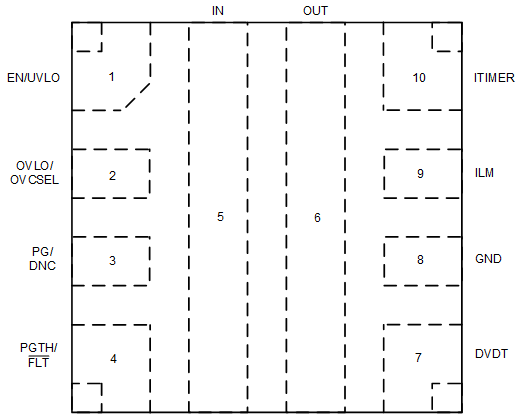SLVSGG5C november 2021 – april 2023 TPS2597
PRODUCTION DATA
- 1 Features
- 2 Applications
- 3 Description
- 4 Revision History
- 5 Device Comparison Table
- 6 Pin Configuration and Functions
- 7 Specifications
-
8 Detailed Description
- 8.1 Overview
- 8.2 Functional Block Diagram
- 8.3
Feature Description
- 8.3.1 Undervoltage Lockout (UVLO and UVP)
- 8.3.2 Overvoltage Lockout (OVLO)
- 8.3.3 Overvoltage Clamp (OVC)
- 8.3.4 Inrush Current, Overcurrent, and Short Circuit Protection
- 8.3.5 Analog Load Current Monitor
- 8.3.6 Overtemperature Protection (OTP)
- 8.3.7 Fault Response and Indication (FLT)
- 8.3.8 Power-Good Indication (PG)
- 8.4 Device Functional Modes
- 9 Application and Implementation
- 10Device and Documentation Support
- 11Mechanical, Packaging, and Orderable Information
Package Options
Mechanical Data (Package|Pins)
- RPW|10
Thermal pad, mechanical data (Package|Pins)
Orderable Information
6 Pin Configuration and Functions
 Figure 6-1 TPS2597xx RPW Package 10-Pin
QFN (Top View)
Figure 6-1 TPS2597xx RPW Package 10-Pin
QFN (Top View)Table 6-1 Pin Functions
| PIN | TYPE | DESCRIPTION | |
|---|---|---|---|
| NAME | NO. | ||
| EN/UVLO |
1 |
Analog Input | Active high enable for the device. A resistor divider on this pin from input supply to GND can be used to adjust the undervoltage lockout threshold. Do not leave floating. Refer to Undervoltage Lockout (UVLO and UVP) for details. |
|
OVLO |
2 |
Analog Input | TPS25970x and TPS25974x: A resistor divider on this pin from supply to GND can be used to adjust the overvoltage lockout threshold. This pin can also be used as an active low enable for the device. Do not leave floating. Refer to Overvoltage Lockout (OVLO) for details. |
|
OVCSEL |
Analog Input | TPS25972x: Overvoltage clamp threshold select pin. Refer to Overvoltage Clamp (OVC) for details. | |
|
PG |
3 |
Digital Output | TPS25972x and TPS25974x: Power-good indication. This is an open-drain signal, which is asserted high when the internal powerpath is fully turned ON and the PGTH input exceeds a certain threshold. Refer to Power Good Indication (PG) for more details. |
|
DNC |
Digital Output | TPS25970x: Can be left floating | |
|
FLT |
4 |
Digital Output | TPS25970x: Active low fault event indicator. This pin is an open-drain signal that is pulled low when a fault is detected. Refer to Fault Response and Indication (FLT) for more details. |
|
PGTH |
Analog Input | TPS25972x and TPS25974x: Power-good threshold. Refer to Power Good Indication (PG) for more details. | |
|
IN |
5 |
Power |
Power input |
|
OUT |
6 |
Power |
Power output |
|
DVDT |
7 |
Analog Output | A capacitor from this pin to GND sets the output turn on slew rate. Leave this pin floating for the fastest turn on slew rate. Refer to Slew Rate (dVdt) and Inrush Current Control for details. |
|
GND |
8 |
Ground |
This pin is the ground reference for all internal circuits and must be connected to system GND. |
|
ILM |
9 |
Analog Output | This pin is a dual function pin used to limit and monitor the output current. An external resistor from this pin to GND sets the output current limit threshold during start-up as well as steady state. The pin voltage can also be used as analog output load current monitor signal. Do not leave floating. Refer to Circuit-Breaker or Active Current Limiting for more details. |
|
ITIMER |
10 |
Analog Output | A capacitor from this pin to GND sets the overcurrent blanking interval during which the output current can temporarily exceed set current limit (but lower than fast-trip threshold) before the device overcurrent response takes action. Leave this pin open for the fastest response to overcurrent events. Refer to Circuit-Breaker or Active Current Limiting for more details. |